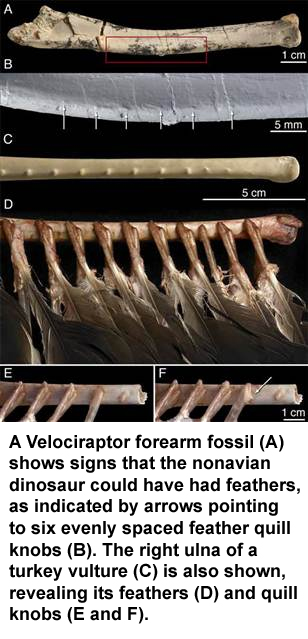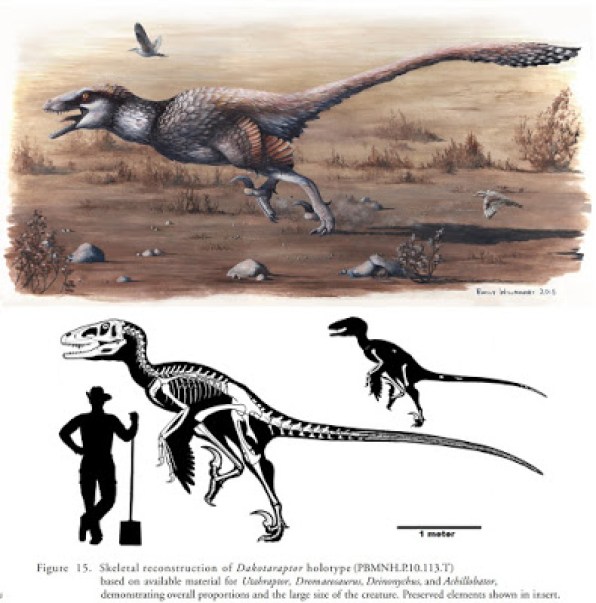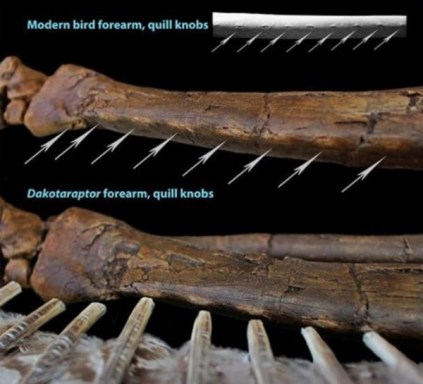Based on a short essay I wrote in April, 2012 (Link), and republished with a few modifications and additions here due to the recent find (July, 2016) of a small feathered dinosaur tail perfectly preserved in amber (Link).
Table of Contents
Similarities between birds and dinosaurs:
 Modern scientists have long believed and taught that modern birds originally evolved from theropod dinosaurs. After all, birds and theropod dinosaurs, or reptiles in general, share many of the same or similar features. For example, like all other reptiles, birds have scales. Also, birds lay eggs as do reptiles. Certain anatomical features, such as the overall musculature, brain, heart, and other organs, as well as the skeletal system, are fairly similar.
Modern scientists have long believed and taught that modern birds originally evolved from theropod dinosaurs. After all, birds and theropod dinosaurs, or reptiles in general, share many of the same or similar features. For example, like all other reptiles, birds have scales. Also, birds lay eggs as do reptiles. Certain anatomical features, such as the overall musculature, brain, heart, and other organs, as well as the skeletal system, are fairly similar.
In short, ancient birds shared the following major skeletal characteristics with dinosaurs (especially the Maniraptora, which includes Velociraptors):
 Pubis (one of the three bones making up the vertebrate pelvis) shifted from an anterior to a more posterior orientation, and bearing a small distal “boot”.
Pubis (one of the three bones making up the vertebrate pelvis) shifted from an anterior to a more posterior orientation, and bearing a small distal “boot”.- Elongated arms and forelimbs and clawed manus (hands).
- Large orbits (eye openings in the skull).
- Flexible wrist with a semi-lunate carpal (wrist bone).
- Hollow, thin-walled bones.
- 3-fingered opposable grasping manus (hand), 4-toed pes (foot); but supported by 3 main toes.
- Reduced, posteriorly stiffened tail.
- Elongated metatarsals (bones of the feet between the ankle and toes).
- S-shaped curved neck.
- Erect, digitgrade (ankle held well off the ground) stance with feet postitioned directly below the body.
- Similar eggshell microstructure.
- Teeth with a constriction between the root and the crown.
- Functional basis for wing power stroke present in arms and pectoral girdle (during motion, the arms were swung down and forward, then up and backwards, describing a “figure-eight” when viewed laterally).
- Expanded pneumatic sinuses in the skull.
- Five or more vertebrae incorporated into the sacrum (hip).
- Straplike scapula (shoulder blade).
- Clavicles (collarbone) fused to form a furcula (wishbone).
- Hingelike ankle joint, with movement mostly restricted to the fore-aft plane.
- Secondary bony palate (nostrils open posteriorly in throat).
 Feathers: Small, probably feathered dinosaurs were recently found in China. It appears that many coelurosaurs were cloaked in an external fibrous covering that could be called “protofeathers.” Also, as pictured below, a report was published (July, 2106) of a portion of the tail of a small feathered dinosaur, perfectly preserved in amber (Xing et al, July, 2016) – discovered in Myanmar. Also, some “dinosaurs”, like velociraptors or the even larger Dakotaraptor or Utahraptor show small knob-like structures along the ulna bone of their forearms that appear to be “quill knobs” used for the attachment of longer features. The quill knobs of Dakotaraptor, (pictured below), have a diameter of about eight to ten millimeters, which shows that the attached feathers must have been fairly large (see pictures below).
Feathers: Small, probably feathered dinosaurs were recently found in China. It appears that many coelurosaurs were cloaked in an external fibrous covering that could be called “protofeathers.” Also, as pictured below, a report was published (July, 2106) of a portion of the tail of a small feathered dinosaur, perfectly preserved in amber (Xing et al, July, 2016) – discovered in Myanmar. Also, some “dinosaurs”, like velociraptors or the even larger Dakotaraptor or Utahraptor show small knob-like structures along the ulna bone of their forearms that appear to be “quill knobs” used for the attachment of longer features. The quill knobs of Dakotaraptor, (pictured below), have a diameter of about eight to ten millimeters, which shows that the attached feathers must have been fairly large (see pictures below).


 Such similarities have long been recognized. Many anatomists between the 1500s to 1800s noticed that birds shared various similarities to reptiles. Then, in 1860, the first specimen of Archaeopteryx lithographica (pictured above) was discovered by a quarry worker in Germany. For many, it was a beautiful example of a “transitional form” between reptiles and birds – and seemed to confirm Darwin’s recently published expectations. J. H. Ostrom’s 1969 description of Deinonychus antirrhopus and its similarities to Archaeopteryx then provided the groundwork for the modern view of birds evolving the ability to fly with the use of feathers. Then, Dr. Gautheir’s cladistic work in the mid-1980’s provided analytical systematic support for the dinosaur-bird evolution theory.
Such similarities have long been recognized. Many anatomists between the 1500s to 1800s noticed that birds shared various similarities to reptiles. Then, in 1860, the first specimen of Archaeopteryx lithographica (pictured above) was discovered by a quarry worker in Germany. For many, it was a beautiful example of a “transitional form” between reptiles and birds – and seemed to confirm Darwin’s recently published expectations. J. H. Ostrom’s 1969 description of Deinonychus antirrhopus and its similarities to Archaeopteryx then provided the groundwork for the modern view of birds evolving the ability to fly with the use of feathers. Then, Dr. Gautheir’s cladistic work in the mid-1980’s provided analytical systematic support for the dinosaur-bird evolution theory.
Contrary interpretations:
 Of course, there has been some disagreement among modern scientists as to the true evolutionary origin of birds. Dr. Alan Feduccia, for example, has been an outspoken opponent of the dinosaur-bird evolution hypothesis. During his 2004 talk at the San Diego History Museum on the origin of birds, he said, “Paleontologists have tried to turn Archaeopteryx into an earth-bound, feathered dinosaur. But it’s not. It is a bird, a perching bird. And no amount of ‘paleobabble’ is going to change that” (Link). During this talk he especially emphasized the following points:
Of course, there has been some disagreement among modern scientists as to the true evolutionary origin of birds. Dr. Alan Feduccia, for example, has been an outspoken opponent of the dinosaur-bird evolution hypothesis. During his 2004 talk at the San Diego History Museum on the origin of birds, he said, “Paleontologists have tried to turn Archaeopteryx into an earth-bound, feathered dinosaur. But it’s not. It is a bird, a perching bird. And no amount of ‘paleobabble’ is going to change that” (Link). During this talk he especially emphasized the following points:
- Archaeopteryx is a true bird.
- “Dinofuzz” is nothing more than collagenic fibers found on many other fossils.
- Today’s highly touted “Feathered Dinosaurs” are a myth: some fossils (i.e. Caudipteryx) have flight-feathers but they aren’t really dinos–they are secondarily flightless birds
- Birds have digits 2-3-4, and theropods have digits 1-2-3. This is powerful evidence that birds couldn’t have evolved from theropod dinos.
- Also, the theropod –> bird hypothesis requires that birds evolved flight from the ground-up. If Caudipteryx has feathers but not for flight, Feduccia finds this explanation quite tenuous. Put simply, ground-up proponents say feathers were pre-adapted for flight but evolved originally for insulation. This is silly because feathers are perfectly suited for flight, and very energetically costly to produce. If insulation was all that was needed, hair would have done the job just fine and would not have been nearly so costly. It strains credibility to say feathers evolved for insulation.
- Feduccia prefers Microraptor as an ancestor of birds because he likes the trees-down hypothesis, not the ground-up hypothesis.
- If birds didn’t come from theropods, this does leave a rather large time-gap where there is essentially no fossil documentation of exactly what sort of dinos or other reptiles from which birds would have evolved.
Of course, the fact that “quill knobs” have been shown on the arms of real dinosaurs like Velociraptors (pictured above) is quite difficult for many scientists to ignore. And, now, of course, add finely preserved feathers to that list. How can the pro and con arguments for key similarities and differences be resolved?
Dinosaurs Evolved from Birds?
Well, some scientists are now arguing that certain kinds of dinosaurs evolved from birds, not the other way around. That’s right, birds came first with their complex feathers and flight adaptations and then at least a few types of “dinosaurs” lost these specialized features when they took to the ground.
Small animals, such as velociraptors, that have generally been thought to be dinosaurs are more likely flightless birds. Raptors look quite a bit like dinosaurs but they have much more in common with birds than they do with other theropod dinosaurs such as Tyrannosaurus. We think the evidence is finally showing that these animals which are usually considered dinosaurs were actually descended from birds, not the other way around…
And perhaps most significant, birds were already found in the fossil record before the elaboration of the dinosaurs they supposedly descended from. That would be consistent with raptors descending from birds but not the reverse.”
– John Ruben, professor of zoology at Oregon State University, ScienceDaily (Feb. 9, 2010)
 Devolution rather than Evolution:
Devolution rather than Evolution:
So, we have yet another example of devolution in action – the same mechanism that produces flightless birds on windy islands or cavefish without eyes. This form of change over time is very easy to explain since it is far easier to break something via mindless mechanisms than it is to create a working complex system to begin with via any known mindless mechanism.
So, the current find of a dinosaur-like tail in amber with feathers is right in line with this concept and simply adds additional support to my original essay (Link). I see absolutely no problem or contradiction here with the biblical perspective on origins or a literal creation week (Link), or recent world-wide Noachian-style Flood (Link).
Again, look as you might, you will not find an example in literature of evolution in action beyond very very low levels of functional complexity (i.e., beyond the level of 1000 specifically arranged amino acid residues), nor will you find a mathematical model that makes any useful predictions as to the success of the mechanism of random mutations and natural selection (RM/NS) at various levels of functional complexity over a given period of time.
In short, faith in the RM/NS mechanism as the primary source of creativity in evolutionary biology for the production of higher level systems of function within gene pools is nothing but fairy tale wishful thinking – not science. Functionally complex differences between different groups of animals, such as the high level functional complexity of true bird feathers, particularly feathers used for flight, can only be explained by deliberate intelligent design, not Darwinian-style evolution – even given a practical eternity of time.











Agreed. Thanks for the encouraging post.
D(Quote)
View CommentSean, I’m not sure I understand your intent in this article. Are you claiming that birdlike dinosaurs devolved from birds and were actually flightless birds?
Bob Helm(Quote)
View CommentThe article is mostly informational, showing that there are in fact bird or “bird-like” characteristics to various creatures that are generally given the title of “dinosaur” by modern science. It is therefore much easier to think of these particular types of “dinosaurs” as flightless birds rather than to imagine the novel evolution of feathered birds from flightless and featherless reptiles…
Sean Pitman(Quote)
View Comment@Sean Pitman: Thanks for your reply; it clarifies your position for me. I’m curious – have you read or seen David Read’s recent book on dinosaurs? He proposes that birdlike dinosaurs were actually bird-reptile amalgams that were produced by antediluvian genetic engineering. David sometimes posts comments on your articles, and I’m wondering about your thoughts on his proposal.
Bob Helm(Quote)
View CommentEven though I’m sure the antediluvians were very intelligent, I’m not sure that they were capable of this level of genetic engineering. I personally don’t see the need to forward such hypotheses… beyond fanciful speculation.
Sean Pitman(Quote)
View CommentFly away, little dinosaur!
kime wesley(Quote)
View CommentFly away, little dinosaur!
kime wesley(Quote)
View CommentAgreed. Thanks for the encouraging post.
D(Quote)
View CommentSean, I’m not sure I understand your intent in this article. Are you claiming that birdlike dinosaurs devolved from birds and were actually flightless birds?
Bob Helm(Quote)
View CommentThe article is mostly informational, showing that there are in fact bird or “bird-like” characteristics to various creatures that are generally given the title of “dinosaur” by modern science. It is therefore much easier to think of these particular types of “dinosaurs” as flightless birds rather than to imagine the novel evolution of feathered birds from flightless and featherless reptiles…
Sean Pitman(Quote)
View Comment@Sean Pitman: Thanks for your reply; it clarifies your position for me. I’m curious – have you read or seen David Read’s recent book on dinosaurs? He proposes that birdlike dinosaurs were actually bird-reptile amalgams that were produced by antediluvian genetic engineering. David sometimes posts comments on your articles, and I’m wondering about your thoughts on his proposal.
Bob Helm(Quote)
View CommentEven though I’m sure the antediluvians were very intelligent, I’m not sure that they were capable of this level of genetic engineering. I personally don’t see the need to forward such hypotheses… beyond fanciful speculation.
Sean Pitman(Quote)
View Comment